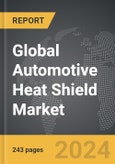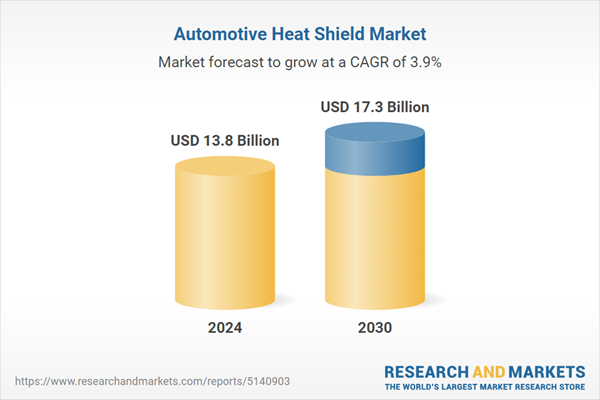The global market for Automotive Heat Shield was valued at US$13.8 Billion in 2024 and is projected to reach US$17.3 Billion by 2030, growing at a CAGR of 3.9% from 2024 to 2030. This comprehensive report provides an in-depth analysis of market trends, drivers, and forecasts, helping you make informed business decisions. The report includes the most recent global tariff developments and how they impact the Automotive Heat Shield market.
Segments: Product (Exhaust Heat Shield Insulation, Exhaust & Header Wrap, Thermal & Heat Shield Sleeving, Turbo Heat Shields, Heat Shield & Thermal Barriers, Other Products); Material (Metallic, Non-Metallic); End-Use (Passenger Cars, Commercial Vehicles).
Geographic Regions/Countries: World; United States; Canada; Japan; China; Europe (France; Germany; Italy; United Kingdom; Spain; Russia; and Rest of Europe); Asia-Pacific (Australia; India; South Korea; and Rest of Asia-Pacific); Latin America (Argentina; Brazil; Mexico; and Rest of Latin America); Middle East (Iran; Israel; Saudi Arabia; United Arab Emirates; and Rest of Middle East); and Africa.
The analysts continuously track trade developments worldwide, drawing insights from leading global economists and over 200 industry and policy institutions, including think tanks, trade organizations, and national economic advisory bodies. This intelligence is integrated into forecasting models to provide timely, data-driven analysis of emerging risks and opportunities.
Global Automotive Heat Shield Market - Key Trends and Drivers Summarized
How Do Automotive Heat Shields Protect Vehicle Components?
Automotive heat shields are essential components designed to protect various parts of a vehicle from excessive heat generated by the engine, exhaust systems, and other high-temperature sources. These shields act as barriers, preventing heat from damaging sensitive components such as electrical wiring, fuel lines, and interior materials, thereby ensuring the vehicle’s safety, performance, and longevity. Heat shields are made from materials that can withstand extreme temperatures, such as aluminum, stainless steel, and composite materials, often with insulating layers that reflect and dissipate heat. The strategic placement of heat shields throughout the vehicle is crucial, as they must cover areas most vulnerable to heat exposure while being lightweight and durable to avoid adding unnecessary weight to the vehicle. As automotive design continues to evolve, the role of heat shields has expanded, making them integral to modern vehicles where space is limited, and thermal management is increasingly complex.How Are Innovations in Materials and Design Enhancing Heat Shield Performance?
The performance of automotive heat shields has been significantly enhanced by innovations in materials and design, driven by the need to improve thermal efficiency while reducing weight. Advances in material science have led to the development of multi-layered heat shields that combine metal and insulating layers to offer superior heat resistance with minimal thickness. These new materials not only improve the heat shield’s effectiveness but also contribute to overall vehicle weight reduction, which is a critical factor in improving fuel efficiency and meeting stringent emissions regulations. Additionally, manufacturers are exploring the use of lightweight composites and ceramic-based materials that offer high thermal resistance while being easy to mold into complex shapes, allowing for more precise and effective coverage of heat-sensitive areas. Design innovations, such as the integration of heat shields into vehicle structures and components, further enhance thermal management by allowing for more efficient use of space and materials, ultimately leading to better protection and performance.What Trends Are Driving the Adoption of Advanced Heat Shields in Modern Vehicles?
Several key trends are driving the adoption of advanced heat shields in modern vehicles, reflecting broader changes in automotive design, technology, and consumer expectations. The increasing demand for higher-performance vehicles, particularly those with turbocharged engines, has led to a greater need for effective heat management solutions to protect critical components from the higher temperatures generated by these engines. Additionally, the rise of electric vehicles (EVs) and hybrid vehicles presents new challenges for thermal management, as these vehicles often require specialized heat shields to protect batteries and other electronic components from both external and internal heat sources. Another important trend is the push towards vehicle lightweighting, which has driven the development of thinner, lighter heat shields that do not compromise on performance. As automakers continue to focus on improving fuel efficiency and reducing emissions, the role of advanced heat shields in achieving these goals has become increasingly important, making them a critical component in modern vehicle design.What Are the Key Drivers Fueling the Growth of the Automotive Heat Shield Market?
The growth in the automotive heat shield market is driven by several factors, each contributing to the increasing demand and innovation in this sector. The growing complexity of modern vehicles, with their compact engine bays and densely packed components, has heightened the need for effective thermal management, driving demand for advanced heat shields. Additionally, the shift towards higher-performance engines, including turbocharged and supercharged variants, has increased the heat generated within vehicles, further fueling the need for robust heat shielding solutions. The rise of electric and hybrid vehicles also plays a significant role, as these vehicles require specialized heat shields to protect sensitive electronic components and batteries from heat damage. Consumer demand for vehicles that offer a balance of performance, efficiency, and comfort is another critical driver, as effective heat shields help reduce cabin heat and improve overall vehicle comfort. Furthermore, regulatory pressures related to emissions and fuel efficiency are compelling automakers to adopt lightweight heat shields that contribute to vehicle weight reduction, further driving market growth. Finally, the increasing focus on vehicle durability and longevity is pushing manufacturers to invest in more durable, high-performance heat shields, ensuring that vehicles can withstand the rigors of daily use without compromising on safety or performance.Report Scope
The report analyzes the Automotive Heat Shield market, presented in terms of units. The analysis covers the key segments and geographic regions outlined below.Segments: Product (Exhaust Heat Shield Insulation, Exhaust & Header Wrap, Thermal & Heat Shield Sleeving, Turbo Heat Shields, Heat Shield & Thermal Barriers, Other Products); Material (Metallic, Non-Metallic); End-Use (Passenger Cars, Commercial Vehicles).
Geographic Regions/Countries: World; United States; Canada; Japan; China; Europe (France; Germany; Italy; United Kingdom; Spain; Russia; and Rest of Europe); Asia-Pacific (Australia; India; South Korea; and Rest of Asia-Pacific); Latin America (Argentina; Brazil; Mexico; and Rest of Latin America); Middle East (Iran; Israel; Saudi Arabia; United Arab Emirates; and Rest of Middle East); and Africa.
Key Insights:
- Market Growth: Understand the significant growth trajectory of the Exhaust Heat Shield Insulation segment, which is expected to reach US$4.8 Billion by 2030 with a CAGR of a 3.7%. The Exhaust & Header Wrap segment is also set to grow at 4.8% CAGR over the analysis period.
- Regional Analysis: Gain insights into the U.S. market, valued at $3.6 Billion in 2024, and China, forecasted to grow at an impressive 5.9% CAGR to reach $3.6 Billion by 2030. Discover growth trends in other key regions, including Japan, Canada, Germany, and the Asia-Pacific.
Why You Should Buy This Report:
- Detailed Market Analysis: Access a thorough analysis of the Global Automotive Heat Shield Market, covering all major geographic regions and market segments.
- Competitive Insights: Get an overview of the competitive landscape, including the market presence of major players across different geographies.
- Future Trends and Drivers: Understand the key trends and drivers shaping the future of the Global Automotive Heat Shield Market.
- Actionable Insights: Benefit from actionable insights that can help you identify new revenue opportunities and make strategic business decisions.
Key Questions Answered:
- How is the Global Automotive Heat Shield Market expected to evolve by 2030?
- What are the main drivers and restraints affecting the market?
- Which market segments will grow the most over the forecast period?
- How will market shares for different regions and segments change by 2030?
- Who are the leading players in the market, and what are their prospects?
Report Features:
- Comprehensive Market Data: Independent analysis of annual sales and market forecasts in US$ Million from 2024 to 2030.
- In-Depth Regional Analysis: Detailed insights into key markets, including the U.S., China, Japan, Canada, Europe, Asia-Pacific, Latin America, Middle East, and Africa.
- Company Profiles: Coverage of players such as Autoneum Holding Ltd., Dana, Inc., ElringKlinger AG, HAPPICH GmbH, Lydall Inc. and more.
- Complimentary Updates: Receive free report updates for one year to keep you informed of the latest market developments.
Some of the 44 companies featured in this Automotive Heat Shield market report include:
- Autoneum Holding Ltd.
- Dana, Inc.
- ElringKlinger AG
- HAPPICH GmbH
- Lydall Inc.
- Morgan Advanced Materials PLC
- Progress-Werk Oberkirch AG
- Tenneco, Inc.
- Ugn Inc.
Tariff Impact Analysis: Key Insights for 2025
Global tariff negotiations across 180+ countries are reshaping supply chains, costs, and competitiveness. This report reflects the latest developments as of April 2025 and incorporates forward-looking insights into the market outlook.The analysts continuously track trade developments worldwide, drawing insights from leading global economists and over 200 industry and policy institutions, including think tanks, trade organizations, and national economic advisory bodies. This intelligence is integrated into forecasting models to provide timely, data-driven analysis of emerging risks and opportunities.
What’s Included in This Edition:
- Tariff-adjusted market forecasts by region and segment
- Analysis of cost and supply chain implications by sourcing and trade exposure
- Strategic insights into geographic shifts
Buyers receive a free July 2025 update with:
- Finalized tariff impacts and new trade agreement effects
- Updated projections reflecting global sourcing and cost shifts
- Expanded country-specific coverage across the industry
Table of Contents
I. METHODOLOGYII. EXECUTIVE SUMMARY2. FOCUS ON SELECT PLAYERSIII. MARKET ANALYSISCANADAITALYSPAINRUSSIAREST OF EUROPESOUTH KOREAREST OF ASIA-PACIFICARGENTINABRAZILMEXICOREST OF LATIN AMERICAIRANISRAELSAUDI ARABIAUNITED ARAB EMIRATESREST OF MIDDLE EASTIV. COMPETITION
1. MARKET OVERVIEW
3. MARKET TRENDS & DRIVERS
4. GLOBAL MARKET PERSPECTIVE
UNITED STATES
JAPAN
CHINA
EUROPE
FRANCE
GERMANY
UNITED KINGDOM
ASIA-PACIFIC
AUSTRALIA
INDIA
LATIN AMERICA
MIDDLE EAST
AFRICA
Companies Mentioned (Partial List)
A selection of companies mentioned in this report includes, but is not limited to:
- Autoneum Holding Ltd.
- Dana, Inc.
- ElringKlinger AG
- HAPPICH GmbH
- Lydall Inc.
- Morgan Advanced Materials PLC
- Progress-Werk Oberkirch AG
- Tenneco, Inc.
- Ugn Inc.
Table Information
| Report Attribute | Details |
|---|---|
| No. of Pages | 243 |
| Published | April 2025 |
| Forecast Period | 2024 - 2030 |
| Estimated Market Value ( USD | $ 13.8 Billion |
| Forecasted Market Value ( USD | $ 17.3 Billion |
| Compound Annual Growth Rate | 3.9% |
| Regions Covered | Global |









